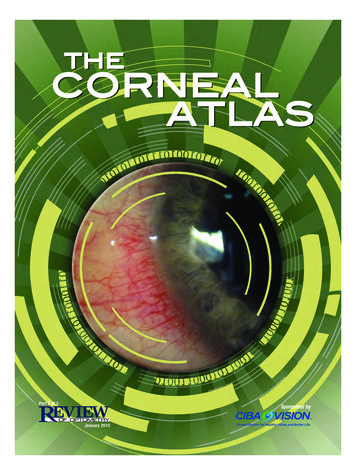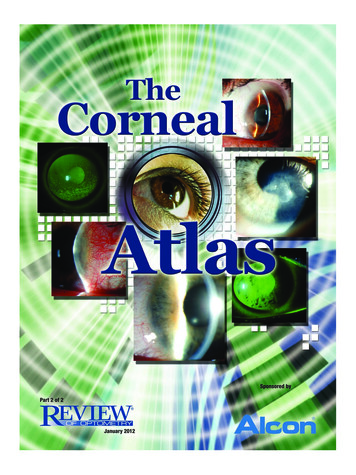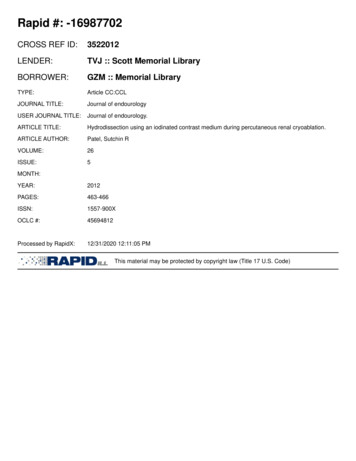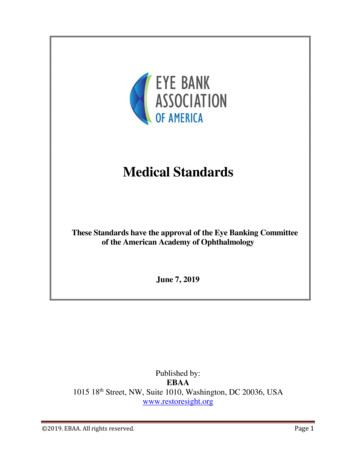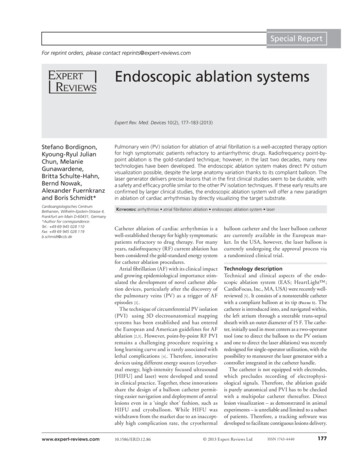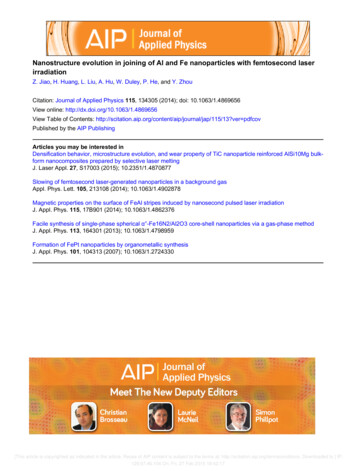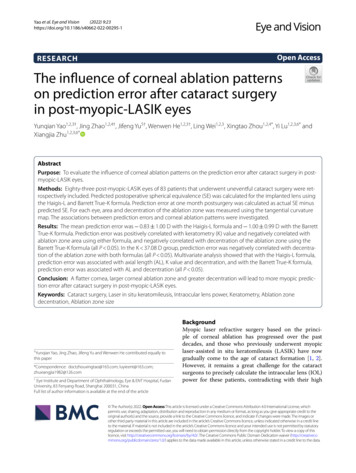
Transcription
(2022) 9:23Yao et al. Eye and en AccessRESEARCHThe influence of corneal ablation patternson prediction error after cataract surgeryin post‑myopic‑LASIK eyesYunqian Yao1,2,3†, Jing Zhao1,2,4†, Jifeng Yu5†, Wenwen He1,2,3†, Ling Wei1,2,3, Xingtao Zhou1,2,4*, Yi Lu1,2,3,6* andXiangjia Zhu1,2,3,6*AbstractPurpose: To evaluate the influence of corneal ablation patterns on the prediction error after cataract surgery in postmyopic-LASIK eyes.Methods: Eighty-three post-myopic-LASIK eyes of 83 patients that underwent uneventful cataract surgery were retrospectively included. Predicted postoperative spherical equivalence (SE) was calculated for the implanted lens usingthe Haigis-L and Barrett True-K formula. Prediction error at one month postsurgery was calculated as actual SE minuspredicted SE. For each eye, area and decentration of the ablation zone was measured using the tangential curvaturemap. The associations between prediction errors and corneal ablation patterns were investigated.Results: The mean prediction error was 0.83 1.00 D with the Haigis-L formula and 1.00 0.99 D with the BarrettTrue-K formula. Prediction error was positively correlated with keratometry (K) value and negatively correlated withablation zone area using either formula, and negatively correlated with decentration of the ablation zone using theBarrett True-K formula (all P 0.05). In the K 37.08 D group, prediction error was negatively correlated with decentration of the ablation zone with both formulas (all P 0.05). Multivariate analysis showed that with the Haigis-L formula,prediction error was associated with axial length (AL), K value and decentration, and with the Barrett True-K formula,prediction error was associated with AL and decentration (all P 0.05).Conclusion: A flatter cornea, larger corneal ablation zone and greater decentration will lead to more myopic prediction error after cataract surgery in post-myopic-LASIK eyes.Keywords: Cataract surgery, Laser in situ keratomileusis, Intraocular lens power, Keratometry, Ablation zonedecentration, Ablation zone size†Yunqian Yao, Jing Zhao, Jifeng Yu and Wenwen He contributed equally tothis paper*Correspondence: doctzhouxingtao@163.com; luyieent@163.com;zhuxiangjia1982@126.com1Eye Institute and Department of Ophthalmology, Eye & ENT Hospital, FudanUniversity, 83 Fenyang Road, Shanghai 200031, ChinaFull list of author information is available at the end of the articleBackgroundMyopic laser refractive surgery based on the principle of corneal ablation has progressed over the pastdecades, and those who previously underwent myopiclaser-assisted in situ keratomileusis (LASIK) have nowgradually come to the age of cataract formation [1, 2].However, it remains a great challenge for the cataractsurgeons to precisely calculate the intraocular lens (IOL)power for these patients, contradicting with their high The Author(s) 2022. Open Access This article is licensed under a Creative Commons Attribution 4.0 International License, whichpermits use, sharing, adaptation, distribution and reproduction in any medium or format, as long as you give appropriate credit to theoriginal author(s) and the source, provide a link to the Creative Commons licence, and indicate if changes were made. The images orother third party material in this article are included in the article’s Creative Commons licence, unless indicated otherwise in a credit lineto the material. If material is not included in the article’s Creative Commons licence and your intended use is not permitted by statutoryregulation or exceeds the permitted use, you will need to obtain permission directly from the copyright holder. To view a copy of thislicence, visit http:// creat iveco mmons. org/ licen ses/ by/4. 0/. The Creative Commons Public Domain Dedication waiver (http:// creat iveco mmons. org/ publi cdoma in/ zero/1. 0/) applies to the data made available in this article, unless otherwise stated in a credit line to the data.
Yao et al. Eye and Vision(2022) 9:23expectations of spectacle independence after cataractsurgery.Selecting an IOL power calculation formula of highaccuracy is a direct and convenient way for most ophthalmologists. In recent years, new formulas, such as theHaigis-L and Barrett True-K formulas, have improvedthe outcomes of these challenging eyes [1, 3]. However,the percentage of patients reaching the emmetropicrange ( 0.5 D) after cataract surgery hardly exceeds 60%[4]. Extreme refractive errors still occur frequently insome cases [5], which is a cause for frustrations that surgeons face.Previous investigations found that corneal asphericity was associated with prediction errors after cataractsurgery in post-LASIK eyes, indicating the potentialinfluence of corneal ablation patterns on the predictiveaccuracy of IOL power calculation formulas [6, 7]. In ourclinical practice, we looked carefully into patients withextreme refractive errors and noticed that the amount ofablation and ablation zone decentration may have a greatinfluence on IOL power calculation of these eyes. However, few studies have investigated this.Therefore, the purpose of this study was to evaluatethe influence of corneal ablation patterns on prediction errors in post-myopic-LASIK eyes, and to helpwith predicting refractive outcomes by optimizingformulas.MethodsThis retrospective study was affiliated with the Shanghai High Myopia Study and registered at www. clini caltr ials. gov (accession number NCT03062085). This wasapproved by the Institutional Review Board of the Eyeand Ear, Nose, Throat (EENT) Hospital of Fudan University (No. 2013021). The study adhered to the tenetsof the Declaration of Helsinki. Informed consents for theuse of their clinical data were obtained from all includedpatients before surgery.PatientsPost-myopic-LASIK eyes that underwent uneventful phacoemulsification and IOL implantation during January 2019 to August 2020 at the EENT Hospitalwere included. Patients were excluded if they had: (1)ocular diseases that could potentially influence thepostoperative refraction (e.g., keratoconus, glaucoma,zonular weakness, uveitis, severe retinopathies); (2) previous trauma or eye surgery other than corneal refractivesurgery, (3) severe complications during or after cataractsurgery, (4) best-corrected visual acuity (BCVA) worsethan 20/40. Finally, 83 eyes of 83 patients were includedin the analysis.Page 2 of 9Preoperative examinationsPreoperatively, all patients underwent routine ophthalmic examinations including visual acuity, slit-lampexamination, fundoscopy, B-scan ultrasonography, andbiometry measurement (IOLMaster 700, Carl Zeiss Meditec AG, Jena, Germany). Corneal topography was measured with a rotating Scheimpflug camera (Pentacam HR,Oculus Optikgeräte GmbH, Wetzlar, Germany) by a single, experienced operator. Patients were asked to openboth eyes and fixate at the illuminant during the measurement. Only the measurements showing “OK” in thequality specification window were qualified for analysis,otherwise the examinations would be repeated. The IOLpower was calculated with the Haigis-L formula availablein the IOLMaster 700 system and further validated withthe Barrett True-K formula (no history) formula availableon the ASCRS website.Surgical proceduresA single experienced surgeon (YL) performed all thesurgeries using a standard procedure. The cataract wasremoved by phacoemulsification through a 2.6 mm clearcorneal microincision, followed by the implantation of anegative aberration aspheric IOL (MC X11 ASP, HumanOptics, Germany) in the capsular bag. Residual viscoelastics (DisCoVisc; Alcon Laboratories, USA) were thenremoved from above and below the IOL, and the incision was hydrated followed by cephalosporin injectioninto the anterior chamber through lateral corneal incisions. Postoperatively, all patients received the same antiinflammatory treatments.Postoperative examinationsUncorrected visual ac he horizontal line in the middle denotes the mean of difference between measurements. a For ablation zone area, 80 (96.4%) of83 eyes were within LOA (range, 1.022 to 1.090 mm2), and the mean of difference was 0.034 mm2. b For decentration, 77 (92.8%) of 83 eyes werewithin the LOA (range, 0.115 to 0.109 mm), and the mean of difference was 0.003 mmFig. 4 Correlations between prediction error and corneal ablation patterns in post-myopic-LASIK eyes. Prediction error was positively related toK value (a Haigis-L formula, Pearson’s r 0.442, P 0.001; b Barrett True-K formula, Pearson’s r 0.235, P 0.033) and negatively related to ablationzone area (c Pearson’s r 0.375, P 0.001 for Haigis-L formula; d Pearson’s r 0.296, P 0.007 for Barrett True-K formula) with both formulas.With the Barrett True-K formula, prediction error was negatively correlated with ablation zone decentration (e Pearson’s r 0.320, P 0.003). D,diopterCorneal ablation patterns and absolute errorsSpearman correlation analysis was further performedto evaluate the influence of corneal ablation patternson absolute errors. Absolute error was negatively correlated with K value (Spearman’s r 0.290, P 0.008for Haigis-L formula, and Spearman’s r 0.239,P 0.030 for Barrett True-K formula), and positively correlated with ablation zone area (Spearman’sr 0.313, P 0.004 for Haigis-L formula, and Spearman’s r 0.253, P 0.021 for Barrett True-K formula)
Yao et al. Eye and Vision(2022) 9:23Page 6 of 9Fig. 5 Correlations between prediction error and ablation zone decentration in post-myopic-LASIK eyes. In the lower K group (K value 37.08 D),prediction error was negatively correlated with decentration with both formulas (a Haigis-L formula, Pearson’s r 0.353, P 0.023; b Barrett True-Kformula, Pearson’s r 0.369, P 0.018). However, in the higher K group (K value 37.08 D), prediction error was not significantly correlated withdecentration no matter which formula was used (all P 0.05)and decentration (Spearman’s r 0.284, P 0.009 forHaigis-L formula, and Spearman’s r 0.260, P 0.018for Barrett True-K formula).DiscussionAccurate IOL power calculation is of great importanceand difficulty for eyes that have undergone corneal refractive surgery, attracting the attention of cataract surgeonsall over the world. Three factors are known to contribute to inaccurate predictions: keratometric index error(incorrect keratometric index induced by the change inrelationship between the anterior and posterior cornea),radius error (inaccurate curvature measurements), andformula error (incorrectly estimated lens position) [1, 4].To overcome these problems, more than 30 optimizedmethods have been proposed in the past decades [5],among which, the Haigis-L and Barrett True-K formulas achieved good results as reported in previous studies[4]. However, extreme refractive errors still occur occasionally. Although the accuracy of these formulas hasbeen widely compared and analyzed, there was a lack ofinvestigations into the potential contributing factors onrefractive surprises in their practical applications. Here,we evaluated the influence of corneal ablation patternson IOL power calculation in post-myopic-LASIK eyes,and found that a flatter cornea, larger ablation zone andgreater decentration of prior corneal laser ablation wereassociated with increased myopic refractive error aftercataract surgery. However, the influence of decentrationdecreases with fewer ablations.In our study, neither of the two formulas were foundto have ideal prediction accuracy, and only less than 40%of eyes were within 0.5 D of predicted refraction withboth formulas. This rate was consistent with the 28.21%to 68% for no history methods reported by previous studies [2, 10–13], but significantly lower than the 69.6% to80.8% in virgin eyes [14]. While underestimation of IOLpower and consequent hyperopic outcomes after cataractsurgery often occur in post-myopic-LASIK eyes whenusing normal formulas [15], myopic prediction errorswere frequently reported with some modified formulas[3, 11, 13]. In this study, the proportion of eyes with prediction error greater than 1.0 D was high and almostcoincident between the two formulas, indicating theircommon defect in avoiding great refractive surprisesthereby not being able to detected some underlying influential factors. Furthermore, we found that the distribution of prediction errors was different between the twoformulas, suggesting that the accuracy of the two formulas might be influenced by different factors.Notably, our study identified a more myopic prediction error correlated with flatter corneas and largerablation zones in post-myopic-LASIK eyes using bothformulas. While a lower K value and a larger ablationzone both reflect a larger amount of myopic correction [16–18], it indicates a potential effect of ablationamount on formula accuracy. In tandem, Vrijmanet al. suggested that when the excimer laser correction of myopia exceeded 6.0 D, more myopic prediction errors and higher absolute errors were obtainedafter cataract surgery [19]. There are several reasonswhich may explain the result: (1) The ASCRS formulasdeveloped linear regression models based on a smallsample size (e.g., 40 eyes of 20 patients for the Haigis-Lformula [1]) and a limited range of myopic correctionor corneal power, and thus those eyes with extreme K
Yao et al. Eye and Vision(2022) 9:23values may not be in accordance with the calculatedlinear regression relationship [4, 20]; (2) The ratio ΔK/ΔSE decreases to less than one with the increase in theamount of myopic correction [20, 21], therefore, effective K value (equaling the preoperative K value minusΔSE at the corneal plane [22, 23]) derived from therefractive history method might be smaller than theactual K value for more-ablated corneas, leading to anoverestimation of IOL power and a myopic predictionerror after cataract surgery. These may explain why Kvalue significantly influenced the accuracy of the Haigis-L, which is known to develop regression modelsbased on the refractive history method [1, 4], and theBarrett True-K formulas in our study population.Other factors may also account for the size of the ablation zone. As the central corneal curvature is usuallydetermined by paracentral measurements, for small ablation zones, it is more likely to be measured on the periphery of treated zones [5], and thus lead to the steepness ofcorneal curvature gradient across the ablation zones andfor an overestimated central corneal curvature, resultingin more hyperopic outcomes as confirmed in our study.However, while the ablation zone area and K value bothreflect the amount of myopic correction, K value exhibited more robust predictability for IOL power calculationaccording to the multivariable regression analysis.One of the most interesting findings of this study is thatablation zone decentration had a significant influence onIOL power calculation, which has long been overlooked inprevious investigations. Decentered ablation is among themost common complications of corneal refractive surgery,resulting from the misalignment of eye-tracking systems,large angle kappa, pupil center shifts after dilation, etc.[24]. In this study, the tangential curvature map was usedfor the evaluation of ablation zone decentration. It cancorrectly highlight the edge of the ablation zone, the siteof highest curvature change, which has been recognizedas a reliable way to evaluate the ablation profile when onlypost-LASIK topography is available [9, 25]. Several reasons may explain this: (1) Extra keratometric index errors.When the ablation is decentered, the thickness of the ablation zone at the corneal vertex is thinner than expected.Therefore, the relationship between the anterior and posterior corneal surfaces has further changed [26–28], leading to extra errors of available formulas which are basedon well-centered ablation models (Fig. 6a); (2) Extra radiuserrors. The IOLMaster measures the corneal curvature byanalyzing six symmetrical light reflections projected ontothe around 2.5 mm ring of the anterior corneal surface[29], therefore, decentered ablation will result in an inaccurate measurement of anterior corneal curvature because ofthe large variations of corneal curvatures within the irregular central cornea; (3) Greater ablation zone decentrationPage 7 of 9Fig. 6 Schematic diagrams showing the influence of cornealablation patterns on prediction errors after cataract surgery inpost-myopic-LASIK eyes. T1, T2, T3 and T4 refer to the thickness ofthe ablation zone at the corneal vertex, while T3’ and T4’ refer to theablation center. a The left two diagrams show a well-centered and adecentered ablation with equal ablation amount. When the ablationis decentered, the thickness of the ablation zone at the cornealvertex is thinner than expected ( T2 T1). Therefore, the relationshipbetween the anterior and posterior corneal surfaces has furtherchanged, leading to extra errors of available formulas which arebased on well-centered ablation models. b The right two diagramsshow different number of ablations with equivalent magnitude ofdecentration. When the amount of ablation is small, the variationin the thickness across the ablation zone is limited (δT3 δT4;δT3 T3’ T3, δT4 T4’ T4). Therefore, the change in the relationshipbetween anterior and posterior corneal surfaces induced by ablationzone decentration and its consequent influence on prediction errorsmight be negligible. However, when the amount of ablation is large,its effects should not be ignoredwill lead to a higher irregular corneal astigmatism whichcan be difficult to correct by cataract surgery [24, 30].Of note, such an association exists in eyes with flattercorneas, but disappears with steeper corneas, indicatingthat the influence of decentration might depend on a particular level of the amount of ablation. This is consistentwith our clinical observations that IOL power can stillbe accurately estimated in some prominently decenteredcases, where a commonality exists in their topography—small amount of ablation as indicated by few concentricrings on the elevation map coupled with steeper centralcorneal surface. This can be due to the limited variationin the thickness of the ablation zone when the amount ofmyopic correction is small. Therefore, the change in therelationship between the anterior and posterior cornealsurfaces induced by ablation zone decentration and itsconsequent influence on prediction errors could be negligible (Fig. 6b). However, when the amount of ablation islarge, its effects could not be ignored.ConclusionsIn conclusion, our study demonstrated that with a cornealtopographic system, the patterns of prior laser ablationcould be evaluated, and flatter corneas, larger ablation zone
Yao et al. Eye and Vision(2022) 9:23and greater decentration might contribute to more myopicprediction errors after cataract surgery in post-myopicLASIK eyes. This should allow the individual refractiveoutcome to be predictable, providing information for preoperative communication and formula optimization.AcknowledgementsNot applicable.Author contributionsStudy design, securing funding, supervision, and critical revision of manuscript(XJZ, YL, XTZ); technical/material support (JZ, JFY.); data acquisition (YQY, JZ,LW); data analysis/interpretation and statistical analysis (YQY, WW.H); draftingthe manuscript (YQY). All authors read and approved the final manuscript.FundingPublication of this article was supported by research Grants from the NationalNatural Science Foundation of the People’s Republic of China (Grant Nos.82122017, 81870642, 81970780 and 81670835), Shanghai High Myopia Study,Science and Technology Innovation Action Plan of Shanghai Science andTechnology Commission (Grant Nos. 19441900700 and 21S31904900), NationalKey R&D Program of China (Grant No. 2018YFC0116800), the Outstanding YouthMedical Talents Program of Shanghai Health and Family Planning Commission(Grant No. 2017YQ011), the Shanghai Talent Development Fund (Grant No.201604), Clinical Research Plan of Shanghai Shenkang Hospital DevelopmentCenter (Grant Nos. SHDC12019X08 and SHDC2020CR4078), Double-E Plan ofEye & ENT Hospital (SYA202006), the WIT120 Research Project of Shanghai (GrantNo. 2018ZHYL0220), and the Shanghai Municipal Key Clinical Specialty Program(Grant No. shslczdzk01901). All the authors have no financial disclosure.Availability of data and materialsThe data that support the findings of this study are available from the corresponding author upon reasonable request.DeclarationsEthics approval and consent to participateThis retrospective study was approved by the Institutional Review Board of theEye and Ear, Nose, Throat (EENT) Hospital of Fudan University (No. 2013021).This study adhered to the tenets of the Declaration of Helsinki. Informed consents for the use of their clinical data were obtained from all included patientsbefore surgery.Consent for publicationNot applicable.Competing interestsThe authors declare that they have no competing interests.Author details1Eye Institute and Department of Ophthalmology, Eye & ENT Hospital, FudanUniversity, 83 Fenyang Road, Shanghai 200031, China. 2 National Health CenterKey Laboratory of Myopia (Fudan University), Key Laboratory of Myopia,Chinese Academy of Medical Sciences, Shanghai, China. 3 Shanghai KeyLaboratory of Visual Impairment and Restoration, Shanghai, China. 4 ShanghaiResearch Center of Ophthalmology and Optometry, Shanghai, China. 5 Department of Ophthalmology, Beijing Children’s Hospital, National Center for Children’s Health, Capital Medical University, Beijing, China. 6 State Key Laboratoryof Medical Neurobiology, Fudan University,
range ( 0.5 D) after cataract surgery hardly exceeds 60% [4]. Extreme refractive errors still occur frequently in some cases [5], which is a cause for frustrations that sur-geons face. Previous investigations found that corneal aspheric-ity was associated with prediction errors after cataract surgery in post-LASIK eyes, indicating the potential
